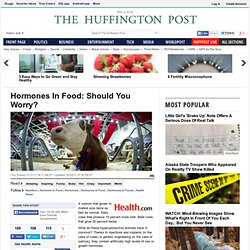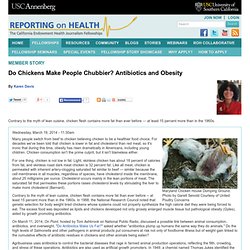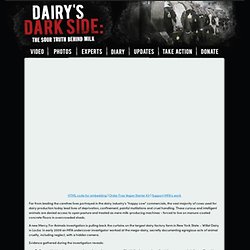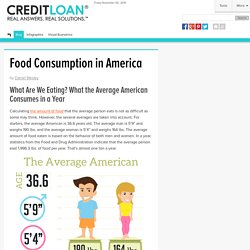

Hormones In Food: Should You Worry? A salmon that grows to market size twice as fast as normal.

Dairy cows that produce 15 percent more milk. Beef cows that grow 20 percent faster. What do these hyper-productive animals have in common? Thanks to injections and implants (in the case of cows) or genetic engineering (in the case of salmon), they contain artificially high levels of sex or growth hormones. Are these hormones dangerous to the humans who eat the food or drink the milk? The FDA, which regulates the use of hormones in livestock, hasn't yet decided whether it will approve the sale of a genetically engineered salmon patented by the biotech company AquaBounty. Antibiotic-Resistant Superbugs In Your Meat Are On The Rise: Report. A new analysis of data collected by federal scientists suggests that a shockingly-high percentage of meat sold in U.S. supermarkets is contaminated with antibiotic-resistant bacteria.

Based on findings from the National Antimicrobial Resistance Monitoring System (NARMS), which were published in February but went largely overlooked, the Environmental Working Group found such bacteria in 81 percent of raw ground turkey, 69 percent of raw pork chops, 55 percent of raw ground beef and 39 percent of raw chicken parts purchased in stores in 2011.
These microbes are superbug versions of pathogens that, even in their milder forms, have devastating potential, including salmonella, E. coli and Campylobacter jejuni. The EWG report also pointed to other studies that suggest there are concerning levels of pathogens such as Yersinia enterocolitica and Staphylococcus aureus in meat. The rate at which these superbugs are spreading is particularly alarming. Read the full EWG report here. Food Empowerment Project. Slaughtering animals and processing their flesh is an inherently dangerous industry where company profits consistently take priority over workers’ most basic rights.

Today, U.S. slaughterhouses and “meat”-processing facilities employ over 500,000 workers.[1] In their endless goal of higher volume and greater efficiency, these corporations knowingly jeopardize workers’ safety every day. For decades, the state and federal agencies responsible for ensuring a safe and healthy work environment have thoroughly failed to institute and enforce basic labor laws to protect these workers. The result is an industry where corporations set the rules and government agencies follow.
Consequently, workers’ most basic rights and interests are compromised and the animals suffer greatly. About the Workers. Do Chickens Make People Chubbier? Antibiotics and Obesity. Maryland Chicken House Dumping Ground.

Photo by Garett Seivold Courtesy of United Poultry Concerns Many people switch from beef to chicken believing chicken to be a healthier food choice. For decades we've been told that chicken is lower in fat and cholesterol than red meat, so it's ironic that during this time, obesity has risen dramatically in Americans, including young children. Chicken consumption isn't the prime culprit, but it isn't blameless either. For one thing, chicken is not low in fat. Contrary to the myth of lean cuisine, chicken flesh contains more fat than ever before -- at least 15 percent more than in the 1960s.
Care2. Banned Ingredients: Unhealthy Food Additives in US Food. You think the FDA has your back?

Sure, they recently proposed two new regulations to up food safety measures, specifically how food processors and farmers can work better to keep their fresh products free of dangerous bacteria (remember that killer cantaloupe outbreak from 2011?). But while it may seem like the government is out to protect us from bad—even fatal—food-borne illnesses, which cause some 3,000 deaths a year, they don't completely have our best interest—or health—in mind. “For numerous suspicious and disturbing reasons, the U.S. has allowed foods that are banned in many other developed countries into our food supply,” says nutritionist Mira Calton who, together with her husband Jayson Calton, Ph.D., wrote the new book Rich Food, Poor Food due out this February.
“If you see any of the following ingredients listed on the nutrition label, don’t buy the product,” Calton warns. RELATED: Eating healthy doesn't cost as much as you think! RELATED: Trying to lose weight? How Many Pus Cells Are In Your Milk. Dairy Investigation. HTML code for embedding | Order Free Vegan Starter Kit | Support MFA's work Far from leading the carefree lives portrayed in the dairy industry's "happy cow" commercials, the vast majority of cows used for dairy production today lead lives of deprivation, confinement, painful mutilations and cruel handling.

These curious and intelligent animals are denied access to open pasture and treated as mere milk-producing machines - forced to live on manure-coated concrete floors in overcrowded sheds. A new Mercy For Animals investigation is pulling back the curtains on the largest dairy factory farm in New York State – Willet Dairy in Locke. In early 2009 an MFA undercover investigator worked at the mega-dairy, secretly documenting egregious acts of animal cruelty, including neglect, with a hidden camera.
Evidence gathered during the investigation reveals: In a joint statement, internationally renowned experts, including Dr. New York veterinarian, Dr. Vegan. Food Consumption in America. By Daniel Wesley What Are We Eating?

What the Average American Consumes in a Year Calculating the amount of food that the average person eats is not as difficult as some may think. However, the several averages are taken into account. For starters, the average American is 36.6 years old.